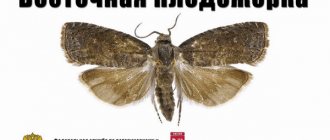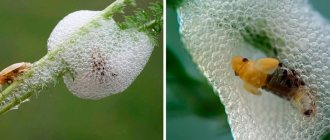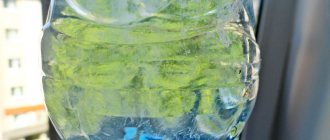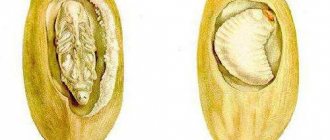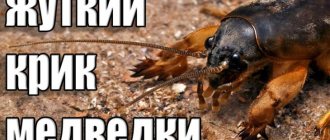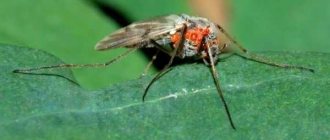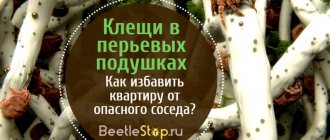Those caterpillars that eat apples are moths . And these are the most common and dangerous pests (since there are several types of them).
The most common are apple and oriental. These are butterflies whose larval stage feeds on both the pulp and seeds of the growing apple tree fruit. What causes its early fall and rapid decay. During a pest outbreak, up to ¾ of the entire apple harvest may be lost. In this article we will tell you how to save an apple tree from the codling moth .
Codling moth
Distributed throughout Russia in areas where fruit growing develops. It feeds exclusively on fruits and can destroy up to 90% of the crop in a season.
Main characteristics of the butterfly:
- color – gray-brown, with dark brown spots, transverse dark stripes and an oval yellowish spot at the top of the wing;
- the shape of the folded wing is roof-shaped;
- wingspan – 16–23 mm;
- body length 8–12 mm;
- laid eggs are light green, up to 1 mm in diameter;
- fertility – 50–200 eggs;
- number of generations per season – 1–3 depending on climatic conditions;
- peak flight - 10–12 days after the apple tree begins to bloom;
- egg laying – 7–10 days after the end of flowering when the average ambient temperature is +16…+18 °C.
Caterpillar:
- color – pale pink or flesh-colored with gray warts;
- head – brown;
- length – up to 22 mm;
- the pupa is light brown or beige with a golden tint, 9–12 mm long.
Life cycle
Mature individual of the first generation
The mass flight of sexually mature butterflies begins during the formation of the ovary on the apple tree and continues for 45–60 days. Maximum activity is observed in the evening hours, after sunset.
During this period, mating of individuals occurs, which ends with the stage of laying eggs. First of all, the pest lays eggs on the upper side of the leaf, then on the fruit.
Egg
In the laid egg, embryonic development begins, which lasts 9–12 days. During this period, the ambient temperature reaches a stable value of +20…+22 °C.
The development of second and third generation embryos requires significantly less time - 3–5 days from the start of laying.
Larva (caterpillar)
The hatching of caterpillars begins 15–17 days after the end of flowering of the latest varieties of apple trees.
Within 1–3 hours, the caterpillar moves to the fruit, and from that moment its defeat begins, which consists of several stages and is accompanied by stages of larval development:
- the caterpillar covers the selected fruit with a thin, almost invisible web;
- within 10–30 minutes it selects the most vulnerable place, gnaws through the skin and penetrates into the pulp of the fruit;
- having penetrated the fruit to a depth equal to the length of its own body, the caterpillar turns its head towards the hole and closes the passage with a dense plug consisting of pulp and cobwebs;
- for 24–48 hours the caterpillar feeds on the subcutaneous pulp, then gnaws out the chamber and molts in it for the first time;
- over the next 48 hours, it gnaws a hole into the seed chamber and molts a second time;
- having destroyed the seeds in the chamber, the larva molts again;
- the last, fourth, stage of caterpillar development is accompanied by gnawing the exit from one fruit and moving to another.
The affected apple often appears ripe ahead of time, falls off, and rots. During the season, one caterpillar destroys up to 3 fruits.
A mature larva forms a dense cocoon in cracks in the bark of an apple tree or in the soil, at a depth of no more than 3–4 cm, while uncollected fallen leaves or weeds serve as additional shelter and protection.
Doll
When a stable temperature of +8...+10 °C is established in the spring, the caterpillar begins the pupation process. The development of the pupa lasts for 14–25 days and ends with the emergence of butterflies during the period when the apple tree begins to bloom.
Reader questions:
Do starlings on an apple tree eat caterpillars?
Although there is information circulating on the Internet that these birds feed on the caterpillars of this harmful insect, this is not so. They are pecked en masse only by different types of tits , and then at the moment of their emergence from the apples and crawling to wintering places.
Flowers protecting the apple tree from worms
Another “panacea” for worms in apples from the Internet, especially spread by supporters of “BIO-farming”, is planting special types of flowers under apple trees that scare and kill the pest.
It’s a pity, but this method cannot give anything other than disappointment and a crop lost from the pest, because biology is not “led” by fashion trends, and the butterfly does not die only from the smells of plants .
Regular treatment of apple trees against codling moths in the summer will provide many tasty apples in the fall and winter!
Oriental codling moth
Distribution: central Russia, southern regions, Crimea. A dangerous apple tree pest damages fruits and young shoots of the first year of growth. During the season it can destroy up to 100% of the crop.
It is a quarantine pest: the import of seedlings from places of mass development of the eastern codling moth is prohibited.
Main characteristics of the butterfly:
- color – dark gray and gray-brown, with off-white scales on the front wings, transverse light stripes and gray fringe;
- the shape of the folded wing is roof-shaped;
- the lower part of the wing is silver;
- antennae – gray, up to 24 mm long;
- wingspan – 10–14 mm;
- laid eggs are transparent, with a pearlescent tint, as they mature - pink, with a diameter of up to 0.4 mm;
- fertility – 180–200 eggs;
- the number of generations per season is 5–6.
Caterpillar:
- color – pale pink, flesh or white;
- head – black;
- length – 12–13 mm;
- pupa – brown, with sharp spines, 6–8 mm long;
- cocoon is transparent, length 10–12 mm.
Life cycle
Mature individual of the first generation
In spring, when the average daily temperature reaches +14…+16 °C, butterflies begin to emerge. The greatest activity is observed in cloudy weather and after sunset. After 3–5 days, the laying of eggs of the first generation begins on the upper side of the apple tree leaf, which lasts for 7–14 days.
Mature individuals of the second and subsequent generations lay eggs on fruits and stalks.
Egg
Embryonic development lasts 3–12 days depending on temperature conditions.
Larva (caterpillar)
Hatched caterpillars of the first generation penetrate the apical bud of a young shoot and gnaw through a passage up to 12 cm long, completely disrupting the sap flow and destroying the structure. The damaged shoot becomes unviable, dries out and dies. The mature larva pupates inside a dead shoot or in cracks in the tree bark.
The larvae of the second and subsequent generations feed on fruits and mature similarly to the caterpillars of the codling moth, but they rarely infect the seed pod, preferring apple pulp.
The average duration of larval development is 10–22 days, depending on the generation.
Doll
Pupae of the second and subsequent generations mature under fallen leaves, on the surface of damaged fruits or inside shoots damaged by the larvae of the first generation.
The maturation stage lasts for 5–10 days, then the development of the next generation begins.
The latest generation of caterpillars form cocoons in the upcoming wintering areas: in damaged bark, in uncleaned dry debris under a tree and in the soil at a depth of 2–3 cm.
The full development cycle from egg laying to subsequent maturation of a mature individual is 22–30 days.
Geographical distribution
The homeland of the eastern codling moth is considered to be China, Korea and Japan. Nowadays, the pest belongs to species common in the subtropical and southern temperate zones. In the Russian Federation and in the post-Soviet space it is found in the Astrakhan region, Stavropol and Krasnodar, North Caucasus regions, Belarus, Ukraine, Moldova, Lithuania.
In Europe, the eastern codling moth has been recorded in Austria, Germany, France, Switzerland, Italy, Spain, Poland, Romania, Hungary, Bulgaria, and the Czech Republic.
The codling moth also originated from the warm climate of Eurasia. And since the main factors limiting the spread of the codling moth are average temperatures below +12°, today they can be found almost everywhere where apple trees are found .
Damage caused
The oriental codling moth causes irreparable damage due to significant damage to the tree. Such apple trees:
- do not develop due to the death of new shoots;
- lose frost resistance;
- have weak immunity to fungal or viral diseases;
- even after getting rid of the pest, they give a low yield due to disruption of the formation and development of new branches.
The yield loss is 100%, since due to the large number of generations and eggs laid, each fruit is attacked by up to 5–7 larvae.
The codling moth leads to a loss of 90% of the harvest, while its impact significantly reduces the tree's frost resistance and immunity to fungal diseases.
Related species
Morphologically close to the apple and eastern codling moths is the Plum moth, which has the difference of having a blue color with a metallic tint on the back of the wings and an orange color of the caterpillars. The pear codling moth is also close to the described pests.
All of them are similar in appearance, behavior and method of damage to fruits.
The orchard is constantly exposed to the invasion of dangerous harmful insects - butterflies, beetles, caterpillars, and in order to preserve the harvest, and even the life of the tree, it is important to know how to get rid of them. Read on our website materials about the most insidious pests of apple trees and other fruit trees: the hawthorn butterfly, gypsy and ringed silkworms, sapwood beetles and leaf miners.
Pest control methods
It is possible to destroy adult individuals and larvae of the codling moth only through complex action. It is important to know that the codling moth larva - the caterpillar - is the weakest and most unstable link in development. The main control measures aimed at its destruction lead to the complete ridding of plantings from the pest.
Mechanical method
The mechanical way to get rid of the codling moth is as follows:
- removal of young shoots in the initial stage of infection by the eastern codling moth, while the cut areas must be cleaned and treated with garden varnish;
- collecting fallen fruits;
- collecting caterpillars from the surface of bark, leaves and fruits by hand;
- applying trapping belts in the lower and middle parts of the trunk in early spring before the butterfly begins to emerge.
Collected waste, damaged or affected parts of the plant must be destroyed by burning.
You can make a hunting belt yourself. To do this, take several strips of fabric or thick cardboard, dip them in an adhesive solution or grease them with Vaseline and secure them to the trunk and skeletal branches of the apple tree. As such a belt, you can use adhesive fly tape attached to fabric to avoid sticking to the trunk - the sticky solution is difficult to wash off and can damage the bark.
The following devices are used to kill butterflies:
- Pheromone trap . It is a triangular prism with a sticky bottom and a bait - a preparation containing codling moth pheromones that attract butterflies. Once trapped, the pest sticks to the tape and dies within 4–6 hours. For effective destruction, the adhesive tape should be replaced at least once every 7-10 days. One trap affects pests living on 3–5 trees.
- Sweet trap . To make it, you should prepare apple compote, adding three times the amount of sugar to it. Pour the prepared liquid into a container with a wide bottom and place it near trees. Considering that butterflies fly most often in the dark, a light source should be installed next to the trap - a table lamp or lantern. Codling moths, attracted by fire, fly to the trap site and drown. In this way, you can destroy 30–40% of butterflies.
Agrotechnical measures
They are carried out for the purposes of prevention, protection and as part of a set of measures to combat the pest. Are as follows:
- removal of dry branches damaged by fungal diseases;
- maintaining optimal distances when planting fruit trees;
- healing or removing damaged bark;
- timely destruction of weeds and root shoots from the tree trunk;
- timely fertilization of the apple tree with mineral supplements containing potassium and phosphorus in order to increase resistance to pest damage;
- compliance with the recommended rate of nitrogen fertilizer application;
- autumn and spring cleaning of dry leaves, fallen fruits and weed residues from the tree trunk;
- mandatory digging of the soil under the apple tree at least twice a season, followed by treatment with a pink solution of potassium permanganate or a solution of the biological preparation “Fitoverm”.
Fallen fruits can be collected in an airtight container, the bottom and walls of which are covered with glossy paper. The caterpillars, having left the apple, will not be able to move, will remain at the bottom and will not be able to continue their development.
Fighting with chemicals
Chemical control is an effective way to get rid of codling moths at any stage of development, and it is important to treat the affected plant throughout the season. To destroy the pest, use any of the drugs, diluted according to the attached instructions:
- "Coragen Expert Garden" . Does not cause addiction among pests. It affects all stages of pest development - from oviposition, larvae of all ages to adults. The first treatment with a working solution at the rate of 0.2 ml per 10 liters of water is carried out during the mass hatching of the larvae from eggs, 2-3 weeks after the apple tree blooms (coincides with the beginning of the white acacia flowering). The next 2-4 treatments are done at intervals of 2 weeks.
- "Dimilin" . Characterized by a long (30–40 days) period of exposure. Spray the tree three times at the green cone stage, then during the initial growing season and then after 10–14 days.
- "Kinmiks" . Involves three-time treatment before the beginning of the growing season and then after 12–15 days.
- "Aktellik" . Characterized by high speed of action. Instantly penetrates upon contact with the caterpillar and paralyzes its nervous system, leading to its inevitable death within 12–36 hours.
- "Fufanon" . Phosphorus-containing intestinal insecticide. Causes the death of the larvae within 24 hours.
- "Calypso" . Systemic insecticide of contact-intestinal action against gnawing pests on apple trees. It has a paralytic effect, leading to death, on larvae at various stages of maturation.
Fighting with biological drugs
The use of biological drugs has several advantages over chemicals:
- non-toxic to humans;
- the plants do not cause addiction to the components;
- are not inferior in efficiency;
- contain minerals necessary to nourish the tree;
- allowed to be used 3–5 days before harvest.
To destroy the codling moth, you should use:
- "Fitoverm" . Within 6–12 hours it causes paralysis of the larvae and leads to death within 24 hours. Effective even with extensive caterpillar infestation.
- "Lepidocide" . Safe for humans, effective against all stages of lepidopteran insects. It is used in any phase of tree and moth development.
- "Bitoxibacillin" . Intestinal insecticide. Leads to the death of the caterpillar within 12–36 hours.
Prevention and treatment of apple trees using traditional methods
Spraying the tree and spilling the soil with various infusions increases resistance to diseases and prevents the colonization and development of pests. Infusions are prepared based on:
- Onion peels: brew 3-5 dense handfuls in 5-7 liters of boiling water, leave for 3-5 hours.
- Insecticidal herbs - tansy, wormwood or burdock: 200 g of dried herbs per 5 liters of water.
- Tobacco: 500 g, pour 10 liters of hot water and leave for 2-3 days, dilute with warm water 1:2.
- Red pepper: boil 100 g of fresh fruit in 3 liters of water over low heat for 1–1.5 hours. Cool and dilute with water in a ratio of 1:3.
Thoroughly washing or spraying the apple tree with a soap solution prepared from 150 g of laundry soap and 10 liters of warm water provides protection against diseases and does not allow pests to gain a foothold on the trunk or leaves.
The soap solution can be added to the prepared infusions.
Treatment Chemicals
Spraying of apple trees against harmful insects is carried out with synthetic chemicals based on organophosphorus compounds . But both neonicotinoids and pyrethroids can be used. Below we will look at how to treat an apple tree against codling moths and when, so as not to damage the crop.
Fitoverm
The effect of aversectin (Fitoverm) is complex : penetrating into the caterpillar by absorption into the outer shells during spraying, or after eating apples treated with poison, the poison affects the nervous system of the caterpillar, causing its death.
Attention! The effect of a substance based on “aversectin-S” lasts up to 20 days and cannot be used when pouring apples!
Can we use herbicide?
This is a typical “scam” of modern traders. This substance has nothing to do with HZR, but it can ruin the life of apple trees, because the herbicide is a poison for plants and certainly does not harm the caterpillars.
Advice! Carry out chemical protection of apple trees only with proven preparations from special stores!
Pesticides
Here are the most effective pesticides available on the market that will be effective against worms in apples:
- Pyrethroids: Kinmiks, Karate-Zeon, Lambda-cypermethrin, Sumi-alpha;
- Organophosphorus: Pirimiphos-methyl, Actellik;
- Neonicotinoids (acting systemically): “Tanrek”;
- "Confidor";
- "Talstar";
- "Ram";
- "Fastak".
All of the drugs listed above are from the neonicotinoid family. And all artificial pyrethroids are lipophilic substances that are excellently retained by the cells of apple leaves and fruits and partially penetrate them, guaranteeing an absolute insecticidal effect on caterpillars. But they are applicable only a month before ripening.
Mixed insecticides
How to spray apple trees against codling moths if the garden was previously treated haphazardly and the emphasis was on one particular poison for a number of years? In this case, it is necessary to spray the apple trees with mixtures of poisons. The following tank mixtures are most suitable for this:
- Imidacloprid + Lambda-cyhalothrin;
- Thiamethoxam + Chlorantraniliprole.
Organophosphate insecticides
These compounds (the most famous Dichlorvos, Fozalon, Karbofos, Fufanon ) turned out to be persistent and toxic to nature organochlorine compounds.
These compounds have a low consumption of substance per unit area and a high speed of action on the codling moth, which has made these substances leaders in the fight against caterpillars.
Habitat
Although the butterfly’s homeland is the eastern part of Asia, in particular China, Korea, and Japan, today it can be found on almost all continents of the planet, with the exception of Antarctica. How could an insect cover such distances? And it migrated not on its own, but with the help of man: during the transportation of cuttings, seedlings and fruits around the world, almost invisible larvae and eggs of a harmful butterfly were transported along with them. Now, wherever quinces, pears, peaches, and apple trees grow and bear fruit, the eastern codling moth appears. Photos on the Internet depicting various fruits infected with insects of this species confirm the fact of its distribution on all continents.
conclusions
The eastern codling moth is a quarantine insect. All seedlings, cuttings and fruits that are imported into the territory of Russia, exported from it or moved around the country are necessarily checked by the state quarantine inspection. If even the slightest signs of insect infestation of any type of product are detected, it will be subject to disinfection, and in too severe cases, destruction.
Thanks to this, it is possible to localize foci of infection and partially prevent the spread of the pest. This serves as proof that, despite the treachery of a dangerous enemy, it is possible to fight him, and quite successfully. The main thing is not to hesitate and not to give up, and then you can find a way out of the most difficult situation and protect your garden and harvest.
Preventive measures
Conventional prevention can have a great effect. Of course, it will be effective in the first stages of infection, when the eastern codling moth has just begun to occupy the garden. What needs to be done to prevent excessive infection? The following measures have an excellent effect:
- Removing dead bark from large branches and trunks. If this is not done, then a huge number of caterpillars will remain overwintering under the bark, in cracks, and then next year it will be very difficult to fight the pest.
- Destruction of plant residues, including carrion. Moreover, you need to collect fallen fruits every evening and not leave them overnight: at night, the caterpillars crawl out of the carrion to move to the tree. Therefore, fallen fruits must either be destroyed or buried very deeply, at least 0.5 m.
- Disinfection of containers.
- Digging up the soil in autumn, spring and summer, when the eastern codling moth is in the pupal stage. Moreover, it is necessary to dig not only around tree trunks, but also between rows. Such a measure will significantly reduce the number of harmful insects on the site.
- Regular cutting and burning of damaged shoots.
In addition, it is necessary to arrange bait in the crowns to attract butterflies. You can also place catching belts made of corrugated paper, burlap or other materials soaked in chlorophos on supports and tree trunks in order to catch caterpillars that, having emerged from the crumbled fruits, are looking for a place for pupation or feeding.
How to help a peach recover from illness
Diseases take a lot of strength from a plant, reduce its immunity, and weaken winter hardiness.
To restore strength after treatment, the peach needs to be provided with a balanced diet and fertilized with complex mineral fertilizers. It would also be useful to add organic matter - humus, compost, liquid herbal infusions, etc. To protect against frost before its onset, measures should be taken to insulate the tree. In the first season after suffering from the disease, it is advisable to ration the harvest, directing all efforts to the health and development of the plant. In particularly severe cases, the ovaries must be completely removed. Recently, scientists have developed special preparations to increase plant immunity and enhance their growth. These include:
- Phytoactivators: Stimmunol;
- Albite;
- Immunocytophyte, etc.
- Epin;
- Zircon;
Such preparations can be successfully used to restore peach after illness, following the attached instructions.
Despite the peach's predisposition to many fungal diseases (especially leaf curl) and susceptibility to attacks by pests, with due diligence the gardener can avoid their harmful consequences. To do this, it is necessary to carefully and timely carry out preventive measures, as well as quickly respond to emerging signs of diseases and harmful insects. A wide range of fungicides, insecticides, acaricides and stimulants, when used correctly, will help with this.
Spraying fruit trees against sawfly and leaf roller pests
Apple sawfly
This pest of fruit trees deserves special attention. Already 3-4 days after the apple tree blooms, the rust-colored cuts near the sepals can be used to determine the places where eggs are laid by this pest. The larva will “travel” from the perianth to the ovary for a whole 20 days, and then move on to another fruit, making a secret passage, which will heal in the form of a belt, and will infect the third fruit, which has reached the size of a walnut.
The larva will “travel” from the perianth to the ovary for as long as 20 days, and then move on to another fruit, making a secret passage, which will heal in the form of a belt, and will infect the third fruit, which has reached the size of a walnut.
Look what this pest of fruit trees looks like in the photo:
Many gardeners mistake wormy fruits for those damaged by the codling moth. The sawfly larva damages 3-5 fruits and completely eats up the entire future seed chamber, while the codling moth damages only part of the seeds, and this is their difference.
After three weeks of intensive feeding, the larva of this pest of garden trees will descend to pupate in the soil (3-10 cm) near the tree and will wait here for next spring. But, having waited for it, not all sawflies will be released into the wild; 10-13% of pupae will remain in diapause until the next spring. This is a kind of reserve for survival in the coming years. It is necessary to loosen the soil in tree trunk circles more often, drying out the top layer, which will cause the death of the pest.
To spray fruit trees against sawfly pests, the following products are used: Arrivo, Kreotsid Pro, Inta-Vir, Aktellik, Aktara, Fufanon, Novaktion; and Vermitex.
Leaf roller. In May, the hatching and emergence of leafrollers is intensive: roseate, willow, crooked, reticulated, shy, plump hawthorn, variable fruit (it is she who envelops the flower rosette with a web). And before the end of the month, 6-7 new species of these insect pests of fruit trees will be added, including the subcortical leaf roller, which, unlike those listed above, damages the trunks and skeletal branches of all fruit crops, makes tunnels under the bark, and destroys the trees. That is why, when carrying out protective measures, simultaneously with treating the tree crowns, it is necessary to spray the trunks.
To treat fruit trees and shrubs against these pests, spray with the following preparations: Actelik - 15 ml, Fufan - 10 ml or Iskra - 10 g;
Symptoms and characteristics of the insect
Symptoms of damage are increased flight of butterflies 12-17 days after flowering, as well as the presence of 1 to 5 or more microscopic holes on apple ovaries. Also, the appearance of carrion in the form of apples that look full-sized, but when cut open there are gnaws inside them and the seed chamber has been eaten away.
Eastern codling moth on an apple tree
The oriental codling moth is a dangerous quarantine pest of apple trees. Because in the South it develops in five generations and one apple can sometimes be inhabited by 5-7 larvae “worms”. Because of this, it can completely deprive a summer resident of his apple harvest.
Spreading
This butterfly is distributed throughout the European part of the Russian Federation (with the exception of the tundra zone), as well as the Caucasus and Transcaucasia, the Far East and the Baikal steppes, Central Asia, Siberia, Altai, Southern Belarus and Ukraine. It is most harmful in the steppe zone of Ukraine, the Russian Federation and the mountainous Crimea.
The effect of humidity on the pest
The number of this butterfly is most strongly influenced by atmospheric phenomena.
And in particular, the massive death of its caterpillars is observed during long periods of drought and heat (almost 100%), when the moisture in the atmosphere decreases to 30%.
Caterpillar - what is it?
A caterpillar is a small plump worm. The body is pink or pinkish-reddish in color with grayish dots and has no hairs or pubescence.
The head and cephalothorax are chitinous, reddish-brownish in color, dark and stand out brightly against the apple background. True legs with walking claws are observed.
The hind legs, which are not real, also have claws. The body length of the caterpillars sometimes reaches two centimeters. Below you can see what a codling moth looks like on an apple tree - photos in different life cycles:
Apple codling moth caterpillar.
Codling moth butterfly.
Life cycle of a pest
The cycle with complete transformation, characteristic of the genus of butterflies, consists of the flight of adult butterflies, their mating, the butterfly laying eggs in secluded places, the birth of first instar caterpillars, searching, penetration into an apple and the caterpillar feeding on the fruit, leaving the fruit for pupation.
Number of generations
In the north, in apple orchards, there are two generations of the common codling moth, in the south there are three generations, and for the eastern species and in the southern regions of the Russian Federation the number of generations can reach up to five.
First generation
In the northern regions of apple orchards, the first generation appears from the moment small apples grow, that is, from the end of May to the end of June. In the south it can be noted as early as the beginning of May.
Overwintering stage
In the winter period, as a rule, caterpillars of 4-5 instars enter, in impenetrable silky white cocoons. Most often this is the second or third generation of the moth in a given year.
At the moment, there are no varieties of apple trees that are absolutely resistant to codling moths. The only thing that gardeners have accurately noticed is that apples with tasty and very tasty pulp are more often and more intensively damaged by codling moths, but varieties of the “juice” direction are less “favorite” by caterpillars.
Description and features of the insect
The cluster budworm is a butterfly. The length of an adult reaches 6-8 millimeters, while the wingspan is 11-13 millimeters. Males and females have similar wings covered with a mosaic pattern.
The first pair of wings is distinguished by a brownish tint with spots of different colors - gray, black, brown. The second pair has a gray color and fringe. In a calm state, the wings are fixed above the stomach in the form of a bell.
Life cycle
The cluster leaf roller produces 3 generations per year:
- The first occurs during the period of bud break. Spring summer lasts more than 20 days. 10 days after the start of active summer, the insect lays eggs on the grapes. Most often, this stage coincides with the stage of inflorescence formation. After 6-12 days, caterpillars are born and eat the buds. Each larva is capable of eating up to 60 buds per day. The development of caterpillars ends at the end of the flowering phase. It falls in the first half of June. The caterpillars then transform into pupae. This stage lasts approximately 10 days.
- Secondly, at this stage new butterflies emerge from the pupae. After 2 days they lay eggs. After another 10 days, caterpillars emerge from them. This occurs at the stage of peas and berry development. Caterpillars consume green fruits, forming round holes in them. Damage is visible to the naked eye. Affected fruits become wrinkled and acquire a brown or blue tint. Such berries often suffer from gray rot or other fungal infections.
- Third, butterflies emerge in the second half of July or early August. At this stage, the ripening of early varieties is already observed. Insects finish pupating in October. Most caterpillars do not have time to pupate. They are collected from bushes during harvesting.
What harm can it cause
Pests lead to damage to buds, flowers and fruits. As a result, the yield is reduced to 30-40%. The quality of the fruit is greatly deteriorating.
The cluster leaf roller is capable of entwining flowers and fruits with a web. As a result, the normal formation of generative organs is disrupted. In addition, dense web nests help protect the caterpillars. They eat the pulp of the berries. As a result, the fruits begin to rot.
